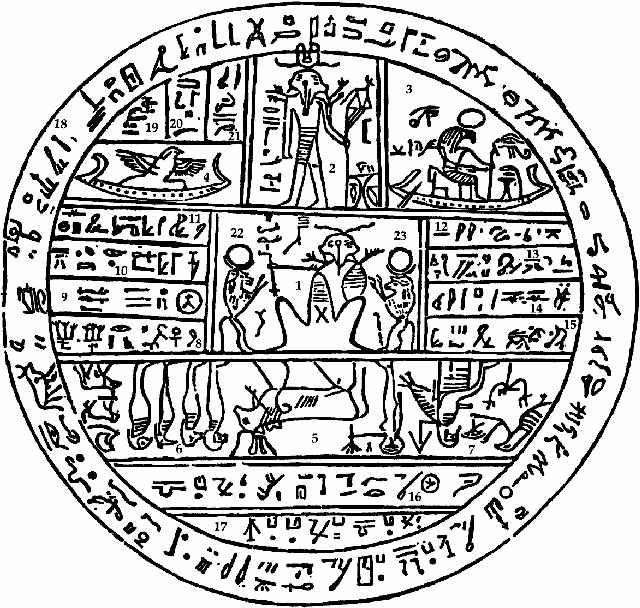SURE they did!

Posted on 07/07/2010 6:22:09 AM PDT by Palter
Possum Creek Stone and Anomalous Cherokee DNA Point to Eastern Mediterranean Origins
In memoriam Gloria Farley
Donald N. Yates
DNA Consultants
Keynote address for Ancient American History and Archeology Conference, Sandy, Utah, April 2, 2010
SUMMARY Three examples of North American rock art are discussed and placed in the context of ancient Greek and Hebrew civilization. The Red Bird Petroglyphs are compared with Greek and Hebrew coins and the Bat Creek Stone. The Possum Creek Stone discovered by Gloria Farley is identified as a Greek athlete’s victory pedestal. The Thruston Stone is interpreted as a record of the blending of Greek, Cherokee, Native American, Egyptian and Hebrew civilization. Keetoowah Society traditions, as captured in The Vision of Eloh’, are adduced to confirm a general outline of the origins of the Cherokee people in a Ptolemaic Greek trans-Pacific expedition joining pre-arriving Greeks, Jews and Phoenicians in the Ohio Valley around 100 c.e. Recent DNA investigations showing Egyptian, Jewish and Phoenician female lineages and the Y chromosome of Old Testament Priests among the Cherokee are also touched upon. Greek words and customs in the Cherokee are reviewed as time permits. Slide projector requested.
A cave entrance overlooking the Redbird River, a tributary of the South Fork of the Kentucky River in Clay County, Kentucky in the Daniel Boone National Forest, has inscriptions which according to Kenneth B. Tankersley of the University of Cincinnati display a nineteenth-century example of writing in the Cherokee syllabary. A local resident (Burchell) recognizes Greek writing in one inscription (called Christian Monogram #2) but his reading is unsatisfactory for a number of reasons. Evaluation by experts in Greek and Semitic epigraphy identifies two distinct inscriptions, one in Greek and one in Hebrew. They appear to be contemporaneous with the Bat Creek Stone unearthed in the 1889 excavation of a tomb in East Tennessee by Cyrus Thomas of the Smithsonian Institution.
Another record of Greek-speaking people in ancient America is the Possum Creek Stone, discovered by Gloria Farley in Oklahoma in the 1970s. It is discussed by her in Volume 2 of In Plain Sight as proof that the man history knows as Sequoyah did not invent the Cherokee syllabary. The inscription can be read as Greek, HO-NI-KA-SA or ‘o nikasa, i.e. “This is the one who takes the prize of victory,” a common inscription for the pedestal upon which victors were crowned at athletic games. The use is Homeric, and the spelling Doric.
A third piece of evidence helps fill in the background of the arrival of Greeks and their intermarriage with Asiatic and other Indians in North America. In 1870, an engraved 19 x 15 inch limestone tablet was uncovered in a mound excavation on Rocky Creek near Castalian Springs in Sumner County, Tennessee (see Ancient American, vol. 12, no. 77). Dating to an earlier time than its Mississipian Period context, it commemorates a peace treaty between the Cherokee and Shawnee. The Cherokee chief wears a horse-hair crested helmet and carries the spear and shield of a Greek hoplite. His Shawnee adversary clasps hands in a wedding ceremony with a Cherokee woman who bears wampum belts as a pledge of peace, has her hair in a maidenly bun, wears a Middle Eastern-style plaid kilt, and displays a large star of David. In the Red Record or Walam Olum, we learn that before crossing the Mississippi, somewhere along the south bank of the Missouri, the Algonquians or Lenni Lenape (Delaware Indians), who are later allied with the Cherokee, encounter a foreign tribe they call the Stonys. Cherokee legends about Stone-coat demonstrate that the original Cherokee had metal armor and weapons. DNA studies confirm a mixture of “anomalous” East Mediterranean mitochondrial lineages such as Egyptian T, Greek U and Phoenician X with “standard” American Indian haplogroups A, B, C and D in the Cherokee and certain other Eastern Woodlands Indians.
To sum up, the Red Bird Petroglyph is a Greek inscription from the 2nd to 3rd century c.e., not a crude Cherokee scratching of around 1800 as announced recently by the Archeological Institute of America and the New York Times. It occurs above what is, in all likelihood, an inscription in Maccabean-era Hebrew. The Sequoyan syllabary for which these Greek and Hebrew inscriptions were mistaken originated in the Greek world of the Bronze Age along with other syllabaries like Linear A, Linear B and Cypro-Minoan. The Cherokee language, which today is Iroquoian, is the result of a relexification process in the distant past. It contains many relics of words of Greek origin, especially in the area of government, military terminology, mythology, athletics and ritual. Cherokee music also reflects Greek origins. The Cherokee Indians are, quite literally, the Greeks of Native America.
Possum Creek Stone and Anomalous Cherokee DNA Point to East Mediterranean Origins (PPT)
Greek Words and Customs in Cherokee
Greek |
|
Meaning |
Cherokee |
Meaning
|
alomenoidakosdasis
tynchanaetheloikeoi*gennadashuios Diosillo, illas*kakotechneo
kanonkaranoskateis*keruxmona*neika*
Ogygesouktennaoulountataskiastixtanawa*
(hoi en) teleitheatas*theatronThraxtypho
|
wanderers (in a hopeless sense)noxious, devouring beast, whalehairy, shaggy like a beastthings that befallvolunteer settlers
nobleSon of Zeus (title of Herakles)wrap, twist; ropebase arts, perjury, fraudstraight-edge used by athletesa chief
assemblyheraldstopping place, way-stationcontesttitan of Greek mythologyone not killed
declared healthyghost, shadeabominableastronomical instrumentthose in authorityspectator in a play
theater, assemblyThracianraise a smoke, make sacrifice
|
eloh’; elohi
dakwadachitikanoeshelokeekanat(i)Su-too Jee
kilohikaktuntakanugaKoranu**cahtiyisskarirosken**
monaanetchaOotschayeUktenaoolungtsataatchina
StichiTchlanuatilihitetchatatetchanuntchaskiri**
Tathtowe,Tistoe |
migrants, wanderers; earthmythic great fish
hairy water monsterhistoryCherokee; original peopledoctor, huntermythic strong mantwisted hair clan (cf. Hawaiian hilo)
taboo regulationscraper used by ballplayerswar chief titleassembly housespeaker, heraldland where the Elohi tarried
ballplayrival of Sutoo Jee (Herakles)name of a dragon or serpentdivining crystal for healthghost; cedarname of dangerous serpent
Great Hawkbrave, warriorPlayful Cherokee fairyceremonial enclosuresorcerer, Stonecladceremonial title; firecracker (smoke) bringer (Santa Claus) |
Oh Pocahontas sailed here from Aotearoa...
O Kaaaay
My apologies for what I’m about to say, but this is pure foolishness, and this “scholar” ought to be ashamed of himself. I’m no linguist, but I have a few years of Greek under my belt, and I also right now am studying Iroquoian languages—of which Cherokee is a member.
Their grammars are COMPLETELY different. As in COMPLETELY. Greek is, like the other Indo-European languages, an inflected language with a root stem on which suffixes are then added: anthropos, anthropoi, anthropou, etc. Cherokee, on the other hand, is an agglutinative language, where the root is buried in the middle of the word. I had difficulty learning Mohawk (which is distantly related to Cherokee) precisely because it wasn’t anything like the Latin/Greek/Italian/French grammars I was used to. It’s a completely different paradigm. Take something as simple as the subject/object of a verb. Greek marks the subject of verbs with a suffix—the object takes a separate word entirely. Iroquoian does it with a huge system of prefixes which have not only the subjects but also the objects embedded in them.
Second, I *guarantee* you, with a corpus of 10000 words between two languages—no matter what those languages are—you will find a few dozen words that look similar and have similar meanings. But he barely even did that: “ouktenna = something not killed” vs. “Uktena name of a dangerous dragon or serpent”? Astronomical instrument and Great Hawk? No serious linguist would take such comparisons seriously.
To prove common descent, you need much much more than a few look-alike words. You need regular variation with established sound laws: like N in one language regularly shows up as T in the other language. Moreover, you have to show it in the most basic, elementary words that are least likely to change as time goes on. Like numbers. Pronouns. Sun, moon, mouth, eye, man, woman, water. Show me comparisons with those words, with regular sound laws. Show me a similar grammar, and then we can talk about common descent.
If Cherokee was descended from Greek, we’d see much much more similarity between them. There is actually very very little. English and Sanskrit are way closer to Greek than Cherokee is.
In short, this article is dead wrong.
Hmmmmmmmmmmmmm
I live in East TN...
some of my grandchildren are Cherokee...
but they were born in Ohio...
With genealogy the No. 1 hobby in the United States today, more and more people are turning to genetics labs to reveal the mysteries of “where do I come from?” Genes do not lie. Yet many tracing their ancestry get results that leave them wondering. They never find out what the numbers and matches truly mean.
Our specialty is integrating genetic and genealogical information into customized personal ancestry reports. We are the only company that is history-based as well as grounded in the sciences.
With our exclusive DNA Fingerprint Test and DNA Fingerprint Plus, as well as our DNA extraction products, we have the most comprehensive offerings in the consumer genetics field. In response to requests from our customers, we recently introduced the first secure and convenient DNA Archiving™ Card.
Our service labs (depending on the test) are Sorenson Genomics and Chromosomal Laboratories, both accredited and acknowledged world leaders in genetic and forensic testing.
Learn more about our labs and scientists here.
Read about our staff here.
Visit our newsroom.
bookmark
And their DNA has been linked to Asia.
So this proves what?
I thought Mr. Yates would want to prove there was a link to Hebrew.
His last name is a common one in Utah. I’m just guessing by his ridiculous supposition that he is indeed one.
Any bets?
Figures. Nice find.
We called him Potty-chair.....
True story..
Funny thing is they didn’t much like “red savages” either.................
50
SURE they did!

SURE they did!

So says “Chief King Gyros” ... ;) I have two years of Koine greek myself, I call bunk.
So language is NOT a good indicator of heredity.

Anglisized from GOETZ as was said in one of the links I followed...
No comment on where the :PANTHER comes from.
But... does he live in Pheonix? or Santa Fe??

May the Schwartz be with you!
That’s Goofy....LOL
Or perhaps they were both descendants of a more ancient culture? Atlantis?
you cheated....LOL
Disclaimer: Opinions posted on Free Republic are those of the individual posters and do not necessarily represent the opinion of Free Republic or its management. All materials posted herein are protected by copyright law and the exemption for fair use of copyrighted works.